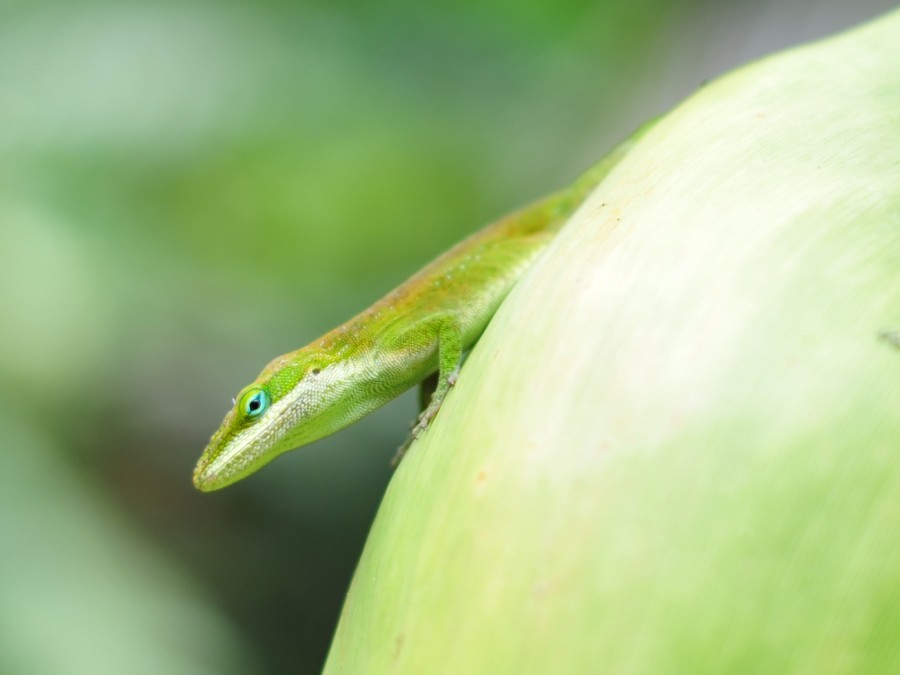UMass professors help revolutionize adhesive world
Within their respective labs and offices on the University of Massachusetts Amherst campus, Professor of Biology Duncan Irschick, and Professor of Polymer Science and Engineering Al Crosby have been quietly creating.
The pair, along with a team of graduate and post-doctoral students, has developed a material that has taken the science world by storm, and, they hope, is one that will revolutionize the adhesive world. This material, called Geckskin, has the thickness of a credit card and the pliability of soft rubber. It can stick to any smooth surface, and a piece of just four square inches can hold up to 700 pounds. With its reusable quality, ability to assume heavy loads, and use of dry adhesion, the product will be usable in everyday scenarios as well as in the health and industry sectors. Earlier this year, Team Geckskin was named by CNN Money as one of the top five science breakthroughs of 2012.
The inspiration for the technology: gecko toes.
Geckskin, as the name suggests, is inspired by the biological anatomy of geckos. By borrowing the technology that geckos use to be able to cling to surfaces at most any angle, and remove themselves without leaving behind any sticky residue, Geckskin is a new kind of adhesive.
The test subjects for the team’s research can be found in the back corner of the second floor of Morrill, one of the campus’s notoriously labyrinth-like buildings. Irschick’s lab, which is home to over two-dozen geckos, is quiet, except for the constant chirping of crickets. Terrestrial tanks, each containing one oblivious gecko, sit side by side on metal shelving racks along the wall. Irschick’s personal office is found just adjacent to the homes of his smaller partners of innovation.
Irschick, began studying the geckos and their adhesive qualities as an undergraduate at the University of California at Davis. He approaches project Geckskin from a biological standpoint. Early on, he was intrigued by the biological make-up of geckos. Today, using the geckos to test their theories, the Geckskin team has been able to anatomically link geckos to the study of adhesion.
“Geckskin is a device, or material that is modeled closely off of a Gecko’s foot,” says Irschick. “Geckos essentially have tendons that go from their bone into their skin…This unusual arrangement really turned out to be the key to Geckskin. Geckskin really relies on three key parts: a very stiff tendon, a skin, which is essentially like Gecko skin, and a soft pad.”
Crosby, who has a Ph.D. in adhesion, says he is able to bring in the “understanding of the mechanics and materials of how adhesion works, from a chemical, physical, and engineering point of view.”
Through their combination of biological and polymer sciences, the team has developed an interdisciplinary approach to the issue of heavy-duty, reusable, sustainable adhesives.
The project was funded by the U.S. Department of Defense (DARPA), and has brought the team great recognition in the past year in the science community and beyond. From investors to potential carriers of the end product, the scientists have been fielding inquiries from a number of different sectors.
“Since the publication of [the first Geckskin] paper [in February 2012], my life has taken a big shift,” Irschick said.
In addition, Crosby and Irschick have received scholarships, grants and awards to encourage future research.
The interdisciplinary nature of the research being done on Geckskin, is one of the main reasons that both Irschick and Crosby work at UMass.
“Being able to work with a vast array of disciplines allows new and different perspectives,” said Crosby. Irschick echoed Crosby’s ideas saying, “If you think about all the ideas that created GeckSkin, that’s the kind of ideas that were borrowed from many different disciplines.”
The idea of Geckskin, judging from the number of people interested in the product, has already proven to be a marketable product. Both Irschick and Crosby are excited about the products potential, not only as a household adhesive, but also as a sustainable option. The sustainability of Geckskin is something that sets it apart from it’s competitors, which are not reusable.
Crosby argues that with further development Geckskin should be a viable sustainable adhesive. “The idea behind Geckskin is that you can reposition and reuse it over and over again. So I think that’s a really big advantage. And we have learned enough that we can actually make it from sustainable materials,” Crosby said.
The team’s understanding of fundamental science has allowed them to develop the product with everyday materials. “It’s a very simple concept… We are using everyday materials, Kevlar, carbon fiber, PDMS. These are materials that have been around for many, many years; it’s nothing exotic.”
Which is part of the appeal. “It is going to be completely affordable,” Irschick says. With everyday materials, and a developed construction plan, the price of Geckskin for public consumption should be comparable or less than the prices that consumers pay for the likes of duct tape and Command Hooks. These characteristics mean that they will be able to market to everyday consumers.
Irschick went on to say “It’s a very simple thing that can be parlayed into a bunch of cool, potential products in the future. It’s a very profound concept, but at the same time, it’s a very simple one. It’s the kind of concept that people can relate to, and kind of sink their teeth into.”
Which luckily, both Crosby and Irschick can use to their advantage. As professors at UMass, they both teach classes in which their research and innovation is applicable to the lesson plan. “Its fun for students to understand that something that they might look at from a gecko, or some kind of animal, could be used in a human product. They love that, and I think that’s great. That’s inspiration and innovation that we all can relate to.” Irschick said.
In addition, the professors are able to expand their own wealth of knowledge to the other’s focus. Crosby, who loves the fact that he is able to present his students with first-hand experiences with the geckos, said “By handling, and watching, and learning from Duncan in his labs, I can now bring that very first person experience into my class and teach. And Duncan can do the same, he doesn’t have to talk about synthetic materials from a second or third person point of view, he can talk about it from a first person perspective.”
The duo has learned a lot from each other in the past years of their collaboration. But they have learned a lot more about the world of adhesives, the ways to better it, and the uses for a product like Geckskin. Both Crosby and Irschick have high hopes for their product, but none that appear to be unfeasible.
Crosby and Irschick share similar goals for Geckskin. They hope to have it commercialized within the next two years.
Crosby’s son would like to see the product in Target stores, and Crosby agrees that that would be “pretty cool to be able to take something from an idea on a whiteboard, or an idea in a lab, and to see it go all the way through. I haven’t done that yet, and I think it would be kind of neat.”
Beyond that, they both would like to see Geckskin have an impact on the way that other technologies are created, and shape the way that people view the sciences. Irschick says that in his innovations and development he would like to be able to leave “a better environment, make something that will make people interested in science, and make people interested in innovation in a positive way.”
The Geckskin team is looking to revolutionize how people think about hanging everyday items. These two professors have spearheaded the innovation of a product that will undoubtedly reshape the adhesive world. And it all started with the toe pads of geckos.
Alexandra Lane can be reached at [email protected]









